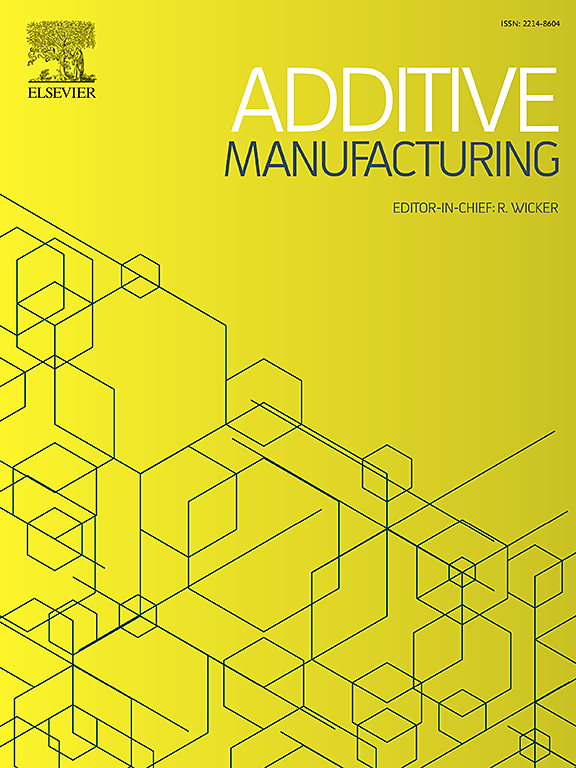电子束粉末床熔合原位合金化Cu-25Cr复合材料
IF 11.1
1区 工程技术
Q1 ENGINEERING, MANUFACTURING
引用次数: 0
摘要
Cu-Cr合金(Cr >10 wt%)由于其高导热性和导电性以及高抗电弧侵蚀性,被用作中压真空断路器的电触点。这种电触点在工业上采用纯Cu和Cr粉末的固态烧结(SSS)或真空电弧重熔(VAR)进行加工。在这项工作中,我们证实了使用元素粉末混合的电子束粉末床熔合(EB-PBF)制备致密Cu-25Cr样品具有精炼和相对均匀的微观结构的可能性。利用SEM成像和EBSD分析对打印后的微观结构进行了表征,同时对EB-PBF Cu-25Cr复合材料的力学、电学和热性能进行了探测,以建立其微观组织-性能关系。EB-PBF复合材料的性能与它们的VAR对应物进行了系统的比较。打印后的微观结构是由于亚稳混相间隙的存在,使得微观结构(微米级的Cr颗粒)比VAR细化了一个数量级。与VAR相比,EB-PBF的微观结构具有优越的机械性能(硬度、屈服强度和极限抗拉强度)、增强的导电性和等效导热性。从影响金属基复合材料力学、电学和热性能的机理出发,讨论了金属基复合材料的微观组织-性能关系。这项工作表明了通过增材制造生产Cu-Cr电触点的兴趣。本文章由计算机程序翻译,如有差异,请以英文原文为准。
Cu-25Cr composites processed by in situ alloying in electron beam powder bed fusion
Due to their high thermal and electrical conductivity and high resistance to arc erosion, Cu-Cr alloys (Cr >10 wt%) are used as electrical contacts in medium voltage vacuum circuit breakers. Such electrical contacts are industrially processed using solid-state sintering (SSS) from pure Cu and Cr powders or vacuum arc remelting (VAR). In this work, we confirm the possibility of fabricating dense Cu-25Cr samples with a refined and relatively homogeneous microstructure by electron beam powder bed fusion (EB-PBF) using elemental powder blending. The as-printed microstructure is characterized using SEM imaging and EBSD analysis while the mechanical, electrical, and thermal are probed to establish the microstructure-property relationships of the EB-PBF Cu-25Cr composite. The properties of the EB-PBF composite are systematically compared to their VAR counterparts. The as-printed microstructure results from the presence of a metastable miscibility gap that refines the microstructure (micron-sized Cr particles) by an order of magnitude compared to the VAR. The fine EB-PBF microstructure shows superior mechanical properties (hardness, yield strength and ultimate tensile strength), enhanced electrical conductivity, and equivalent thermal conductivity with respect to its VAR counterpart. The microstructure-property relationships are discussed in light of the mechanisms affecting the mechanical, electrical, and thermal properties of metal matrix composites. This work demonstrates the interest in producing Cu-Cr electrical contacts by additive manufacturing.
求助全文
通过发布文献求助,成功后即可免费获取论文全文。
去求助
来源期刊

Additive manufacturing
Materials Science-General Materials Science
CiteScore
19.80
自引率
12.70%
发文量
648
审稿时长
35 days
期刊介绍:
Additive Manufacturing stands as a peer-reviewed journal dedicated to delivering high-quality research papers and reviews in the field of additive manufacturing, serving both academia and industry leaders. The journal's objective is to recognize the innovative essence of additive manufacturing and its diverse applications, providing a comprehensive overview of current developments and future prospects.
The transformative potential of additive manufacturing technologies in product design and manufacturing is poised to disrupt traditional approaches. In response to this paradigm shift, a distinctive and comprehensive publication outlet was essential. Additive Manufacturing fulfills this need, offering a platform for engineers, materials scientists, and practitioners across academia and various industries to document and share innovations in these evolving technologies.
 求助内容:
求助内容: 应助结果提醒方式:
应助结果提醒方式:


